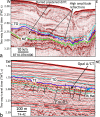Late Eocene onset of the Proto-Antarctic Circumpolar Current
- PMID: 31300669
- PMCID: PMC6626031
- DOI: 10.1038/s41598-019-46253-1
Late Eocene onset of the Proto-Antarctic Circumpolar Current
Abstract
The formation of the Antarctic Circumpolar Current (ACC) is critical for the evolution of the global climate, but the timing of its onset is not well constrained. Here, we present new seismic evidence of widespread Late Eocene to Oligocene marine diagenetic chert in sedimentary drift deposits east of New Zealand indicating prolonged periods of blooms of siliceous microorganisms starting ~36 million years ago (Ma). These major blooms reflect the initiation of the arrival and upwelling of northern-sourced, nutrient-rich deep equatorial Pacific waters at the high latitudes of the South Pacific. We show that this change in circulation was linked to the initiation of a proto-ACC, which occurred ~6 Ma earlier than the currently estimated onset of the ACC at 30 Ma. We propose that the associated increased primary productivity and carbon burial facilitated atmospheric carbon dioxide reduction contributing to the expansion of Antarctic Ice Sheet at the Eocene-Oligocene Transition.
Conflict of interest statement
The authors declare no competing interests.
Figures






Similar articles
-
Southern Ocean biogenic blooms freezing-in Oligocene colder climates.Nat Commun. 2022 Nov 9;13(1):6785. doi: 10.1038/s41467-022-34623-9. Nat Commun. 2022. PMID: 36351905 Free PMC article.
-
Terrestrial cooling in Northern Europe during the eocene-oligocene transition.Proc Natl Acad Sci U S A. 2013 May 7;110(19):7562-7. doi: 10.1073/pnas.1210930110. Epub 2013 Apr 22. Proc Natl Acad Sci U S A. 2013. PMID: 23610424 Free PMC article.
-
Atmospheric and oceanic impacts of Antarctic glaciation across the Eocene-Oligocene transition.Philos Trans A Math Phys Eng Sci. 2015 Nov 13;373(2054):20140419. doi: 10.1098/rsta.2014.0419. Philos Trans A Math Phys Eng Sci. 2015. PMID: 26438285
-
Spatial and temporal operation of the Scotia Sea ecosystem: a review of large-scale links in a krill centred food web.Philos Trans R Soc Lond B Biol Sci. 2007 Jan 29;362(1477):113-48. doi: 10.1098/rstb.2006.1957. Philos Trans R Soc Lond B Biol Sci. 2007. PMID: 17405210 Free PMC article. Review.
-
Geologist at sea: aspects of ocean history.Ann Rev Mar Sci. 2011;3:1-34. doi: 10.1146/annurev-marine-120709-142831. Ann Rev Mar Sci. 2011. PMID: 21329197 Review.
Cited by
-
Genetic diversity of soil invertebrates corroborates timing estimates for past collapses of the West Antarctic Ice Sheet.Proc Natl Acad Sci U S A. 2020 Sep 8;117(36):22293-22302. doi: 10.1073/pnas.2007925117. Epub 2020 Aug 24. Proc Natl Acad Sci U S A. 2020. PMID: 32839321 Free PMC article.
-
Southern Ocean biogenic blooms freezing-in Oligocene colder climates.Nat Commun. 2022 Nov 9;13(1):6785. doi: 10.1038/s41467-022-34623-9. Nat Commun. 2022. PMID: 36351905 Free PMC article.
-
Biogeochemical Traits of a High Latitude South Pacific Ocean Calcareous Nannoplankton Community During the Oligocene.Paleoceanogr Paleoclimatol. 2024 Dec;39(12):e2024PA004946. doi: 10.1029/2024PA004946. Epub 2024 Nov 28. Paleoceanogr Paleoclimatol. 2024. PMID: 39619665 Free PMC article.
-
Reconciling Southern Ocean fronts equatorward migration with minor Antarctic ice volume change during Miocene cooling.Nat Commun. 2023 Nov 9;14(1):7230. doi: 10.1038/s41467-023-43106-4. Nat Commun. 2023. PMID: 37945579 Free PMC article.
-
Fifty million years of beetle evolution along the Antarctic Polar Front.Proc Natl Acad Sci U S A. 2021 Jun 15;118(24):e2017384118. doi: 10.1073/pnas.2017384118. Proc Natl Acad Sci U S A. 2021. PMID: 34108239 Free PMC article.
References
-
- Bryden, H. L., Imawaki, S. Ocean heat transport, in Ocean Circulation and Climate, Siedler, G., Church, J., Gould, J. Eds (Elsevier, New York, 2001), pp. 455–474.
-
- Martinson DG. Antarctic circumpolar current’s role in the Antarctic ice system: An overview. Palaeogeography Palaeoclimatology Palaeoecology. 2012;335:71–74. doi: 10.1016/j.palaeo.2011.04.007. - DOI
Publication types
LinkOut - more resources
Full Text Sources

